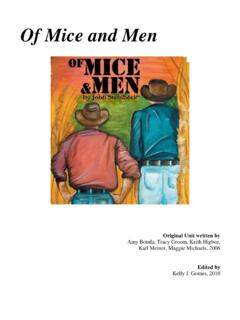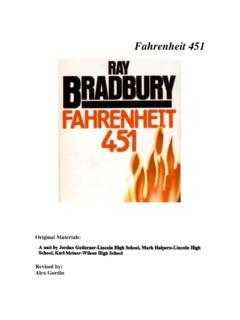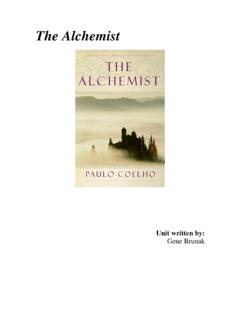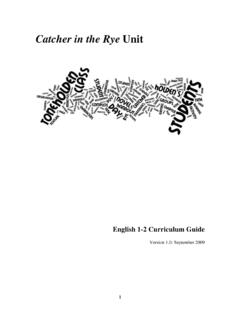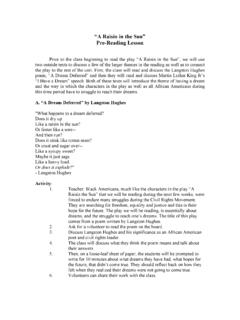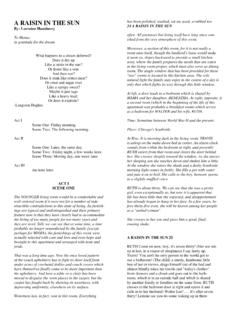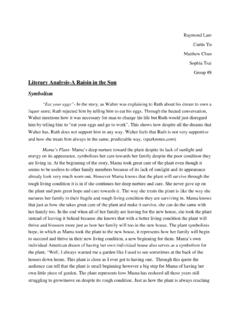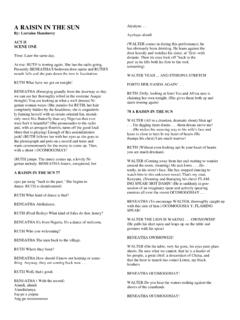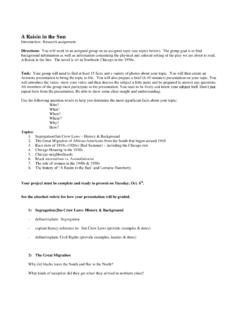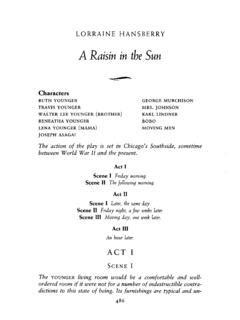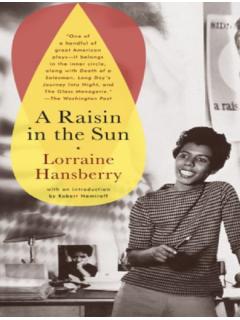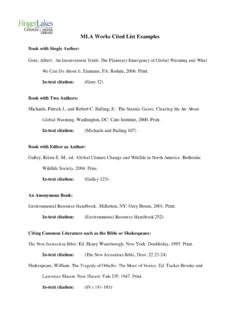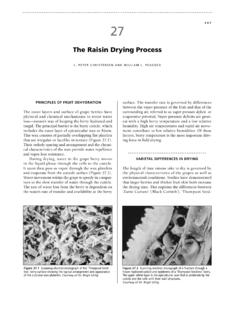Transcription of ¶V A Raisin in the Sun: A Curriculum Guide
1 Lorraine Hansberry s A Raisin in the Sun: A Curriculum Guide Creators: Barbara Brown (Lincoln High School) Jim Peerenboom (Lincoln High School) Virginia Warfield (Grant High School) 2007 DRAFT Funded by Portland Public Schools 2 Table of Contents A Raisin in the Sun Reading and Writing Unit Introduction 3 Model Unit Calendar 5 Criteria and Standards 6 Supplemental Discussion Questions 7 Writing Craft Lesson: Summarizing and Paraphrasing 9 Reading Activity: Daily Free Write 11 Reading Activity: Act 1 Evidence Retrieval Chart 13 Student Model 15 Reading Activity: Character Silhouettes 16 Guided Viewing: Eyes on the Prize 18 Reading Activity: Act 2 & 3 Evidence Retrieval Chart 20 Reading Activity: Connecting Character with Themes Poster 22 Student Handout Planner 23 Student Handout Project Descriptor 24 Student Model (print package only) Guided Viewing.
2 All in the Family 25 Student Handout: Literary Analysis Criteria Sheet 26 Writing Craft Lesson: Developing a Working Thesis 27 Student Handout Thesis Feedback 29 Writing Craft Lesson: Thesis Statements for Literary Analysis 30 Writing Craft Lesson: Writing the Introduction 31 Sample Introductions 32 Writing Craft Lesson: Embedding and Analyzing Quotations 33 Student Handout Practice and Examples 35 Writing Craft Lesson: Using Transitions Part 1 37 Writing Craft Lesson: Using Transitions Part 2 38 Student Model Essay 39 Student Handout: Expository Essay Revision 43 Additional Teaching Resources 44 3 Introduction Literary Analysis Prompt for 11th grade: Choose one of the themes from the American Experience: the immigrant experience, money and morality, race and social justice, and cultural identity in America.
3 Write an analytical essay examining how that theme is developed through the experiences of one of the primary characters in a literary work. Refer to the social or historical context of the work, and use specific and relevant evidence from the text to support your interpretation. There is no dearth of materials and curricula for teaching A Raisin in the Sun. A quick Google search will reveal the many (often very good) websites devoted to exploring the play and its historical context(s). Our purpose was not to reinvent the wheel on this play, but rather to shape the lessons and activities around the common assignment for the Literary Analysis in the eleventh grade.
4 This assignment asks students to examine a theme related to the American Experience as it is developed through a primary character in a work of literature. We saw A Raisin in the Sun as a text full of possibilities for student success with this writing prompt. A family drama exploring cultural and racial identity, aspirations, inter-generational conflicts, and compromised and renewed morals, A Raisin in the Sun has stood the test of time since it was first produced in 1959. In fact, the play was recently revived on Broadway (2004) and won a number of Tony awards.
5 The play also inherently poses questions not just about the civil rights era from which it was born, but also about our own times and the failed promises of the civil rights movements. As such, the play is in and of itself interesting as a reflection of its social, cultural, and historical context, but it can also be a jumping off point for readers to explore our own social, cultural, and historical context. The play critiques and hesitantly embraces the very concept of the American Dream. The play raises a number of essential questions for readers, including some of the following: How do one s race, class, and/or gender influence an individual s goals or aspirations?
6 How do stereotypes of one s race, class, and/or gender influence an individual s goals or aspirations? How do individuals determine or understand their place in society? What is the role of money in attaining the American Dream? When does pragmatism outweigh pride? Students will have the opportunity to explore these questions in relationship to the play and to themselves. The literary analysis prompt provides students with an opportunity for students to explore these essential questions and to possibly come to some conclusions about what it means to live in our society.
7 They will have the opportunity to grapple with some of the most perplexing and important questions in contemporary American society. In reading/viewing both the play and related documents, articles, videos, and poetry, students will be asked to consider essential questions. In writing the literary analysis, students will be asked to analyze 4 and articulate how a work of literature conveys meaning and reflects the society in which it is placed. Additionally, we hope that students will come away from this unit with some enduring understandings, including understanding that.
8 Achieving individual goals often requires overcoming barriers Stereotypes can be limiting and should be confronted and questioned The American Dream represents an often unfulfilled promise that nonetheless should and can be struggled for Money creates many opportunities and conflicts in the pursuit of the American Dream The activities and craft lessons in this unit have been adapted from our colleagues (with much appreciation) who have worked tirelessly on creating Curriculum guides for Portland Public Schools.
9 We have borrowed heavily, as well, from Linda Christensen without whom none of the excellent teaching guides and lessons from the past eight years would exist. We offer a number of reading strategies directed towards the final writing outcome (the literary analysis) and we tried to focus our writing craft lessons on the types of difficulties students typically have in terms of organization, thesis statements, and use of textual examples. We were not exhaustive in providing such lessons, however, and we direct teachers towards the Curriculum Guide addendums created in 2006 (again with the amazing leadership of Linda Christensen) for craft lessons that we have not included here.
10 We have also not been exhaustive in providing activities geared toward teaching the historical context of the play; we have provided some materials and suggested resources, but we believe teachers can access this material more readily than the craft lessons on writing literary analyses. Likewise, we have not focused this Guide on teaching about racism and stereotyping per se, but have provided a limited list of resources for exploring these issues in the context of the play. Our focus has been on helping students and teachers build skills towards successfully writing the 11th grade literary analysis.
